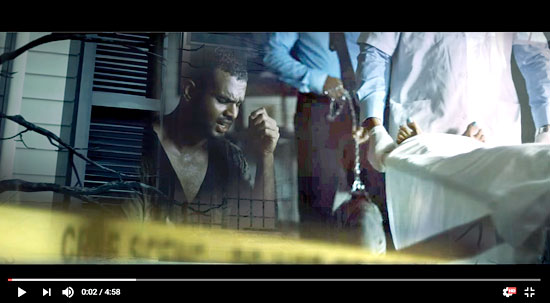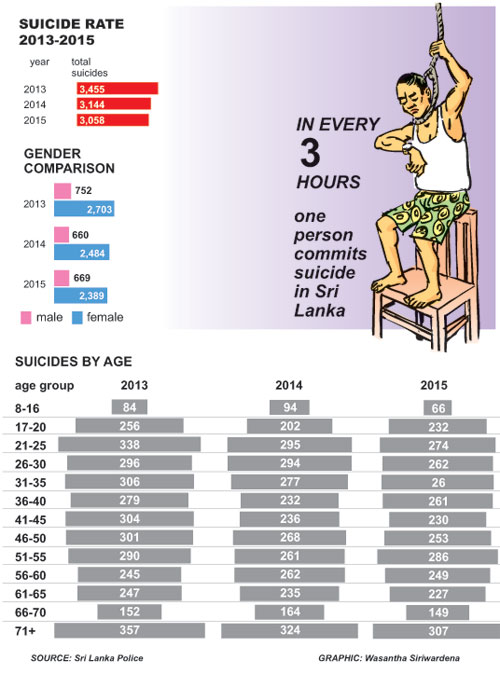|
Suicide Prevention Month:
Music videos newest guide to suicide?
By Isuri Yasasmin Kaviratne
 A
couple on the TV screen cavort romantically to highly popular melodies
but they soon end up in despair and tragedy with cheating in love,
break-up and, finally, suicide by one or the other. This seems to be a
common theme these days. A
couple on the TV screen cavort romantically to highly popular melodies
but they soon end up in despair and tragedy with cheating in love,
break-up and, finally, suicide by one or the other. This seems to be a
common theme these days.
People love music/ songs and choose the genres they enjoy the most.
Coupled with songs, music videos too have become a pervasive and
influential facet of our lives. What is common in many recently released
music videos is this theme of young people caught up in twists of
romantic fate ending in suicide. With the National Suicide Prevention
month under way, the Sunday Observer spoke to experts on suicide
tendencies and music videos. Observing this trend and its impact on
society, Sociologist Prof. Siri Hettige said, today's society is focused
on opportunities surrounding work, money and consumption; music too is
something we consume. "Based on that, we change our behaviours. That's
the danger of these trends in music."
Music and music videos
Dr. Sunil Wijesiriwardena, composer and music scholar, said: "The
main problem with mainstream songs broadcast these days is that they
lack the complexity - in lyrics as well as in music - that would
otherwise contribute to the personal development of the listeners". "We
forget that language is connected to music too, when they are presented
as songs. One's thinking process is determined by their fluency in
languages. This is what most of the FM channels lack, and they determine
the sort of music the public should listen to," he commented.
Certain images can successfully create certain mindsets, arts critic
and feminist cinematographer Anoma Rajakaruna said. "That's how social
stereotypes are created. We know what an ideal mother looks like:
beautiful, lean, wearing a saree, because we have seen her image on TV
for decades. The more it is seen, the more it'll create an impact on the
audience. Then what they see becomes an option in their lives." As a
professional dealing with visual technology and visual literacy, she
added that in today's society, the images people see everyday, such as
advertisements and music videos, determine the good and bad things for
people. Agreeing with his contemporaries, renowned lyricist Sunil
Ariyaratne was even more critical. The veteran writer and critic said,
his disappointment about recently released pop songs concern "... lyrics
that are not good, music that is not good and, visuals that are not
good". He admitted that he stopped listening to newly released songs
about 10 years ago, but is exposed to them on public platforms."Most of
these videos show cheating women and men crying for their lost love,
when they are not committing suicide," he remarked and observed that
"... the presentation of these sentiments are of a primitive nature".
Education
 The
education system has failed to teach us how to cope with our feelings,
especially, negative feelings, Jomo Uduman, Chairman, Sumithrayo Colombo
Centre said. This, coupled with recent social trends where people do not
communicate directly with each other, means that people are not
integrated as human beings should be, he said. He explained, this could
be a reason why some students at medical schools commit suicide. "If
Sumithrayo gets invited to make presentations for students and give them
better guidance on these matters, we would be happy to start such
programs," he said, pointing out that his organization could not
initiate programs without an invite.Furthermore, limitations in school
syllabuses too add to the social dilemma that is presented in music
videos, and are, in turn, seen in the society. The
education system has failed to teach us how to cope with our feelings,
especially, negative feelings, Jomo Uduman, Chairman, Sumithrayo Colombo
Centre said. This, coupled with recent social trends where people do not
communicate directly with each other, means that people are not
integrated as human beings should be, he said. He explained, this could
be a reason why some students at medical schools commit suicide. "If
Sumithrayo gets invited to make presentations for students and give them
better guidance on these matters, we would be happy to start such
programs," he said, pointing out that his organization could not
initiate programs without an invite.Furthermore, limitations in school
syllabuses too add to the social dilemma that is presented in music
videos, and are, in turn, seen in the society.
Wijesiriwardena said: "Syllabuses are limited to subjects and
contemporary consciousness in cultures, and development is not discussed
by the young minds. Math and science have become more important than
developing the minds and hearts of the children."
This is not a fault of the younger generation, but, the older
generation is more responsible for today's plight, for they created
these syllabuses, he commented.
Copycat
Uduman said: "Added to music videos, the media messages that include
graphic images of suicides too contribute to arousing suicidal feelings
among people who are already entertaining those feelings. This copy-cat
syndrome needs to be addressed too," he added. He said, the suicide rate
in Sri Lanka reached high, back in 1995 when the country experienced the
highest suicide rate in the world - 47 for every 100,000. The government
launched a program where life skills training was implemented at
school-level, and in 2000, the suicide rate was reduced to 20, even
though it is still a high rate according to world statistics.
However, Uduman explained that the main problem in Sri Lanka is not
suicides, but attempts at committing suicide."The number of attempted
suicides have not doubled but tripled, as we know since we work with
people having such feelings. Social problems are high, attempts are
high, and no one is keeping records of attempted suicides," he said,
adding that this is the situation heightened by the copy-cat syndrome.
Social consciousness
Many understand these problems as crisis in different sectors;
politic, economic, and so forth. However, Dr. Wijesiriwardena argued, it
is a bigger problem, a 'civilization crisis.' "Our students are not
students anymore, it's the same with every profession, where we face a
moral crisis." What we see in a music video for a few minutes has a
broader and wider social problem."
Adding to this situation, Prof. Hettige explained, relationships seen
today are volatile, not stable. "Today's society is in turmoil, and in
this context, any direct or indirect negative messages, for example
music videos, should be dealt with."The social consciousness has an
element where there is a lack of contribution from the previous
generation to correct the current situation. However, Ariyaratne
concurred that if he writes a song, the problem would be to find someone
to sing it. "Many wouldn't be able to relate to the literature in the
lyrics. Even if a young singer agrees to sing, no TV or radio station
will play that song, or will ask me to pay them to get the song played
on their channels." Explaining the 'golden olden days', Ariyaratne said,
the radio songs were produced at Sri Lanka Broadcasting Corporation (SLBC)
and were recorded at two studios, Sing Lanka and Tharanga, but, both
companies have closed down due to lack of business. Ariyaratne explained
that even the lyrics of songs needed approval back then, and the
approval committee consisted of renowned lyricists such as Madawala S.
Ratnayake and Mahagamasekara. "That's how the quality of the songs was
maintained then. But, I don't think these songs represent the taste in
music of the general public."
The proof for this is the overflowing crowds at music concerts of
Sunil Edirisinghe, Victor Ratnayake, Nirosha Virajini and Kasun Kalhara.
"People still admire good music, but we are not sure of the kind of
impact the new songs would have on the general public."
Reforms
Wijesiriwardena said, reforms are good, but the problem goes deeper.
"If we don't find a way to heal everything, suicide and alienation from
society will become part of us."However, Ariyaratne said, appointing a
regulatory committee for songs would create opposition, claiming that
art is being censored. On the other hand, Rajakaruna said, "I believe in
artistic freedom and expression, and would not like to advocate against
it, but artists should be more aware of the placement of their creation
in society."
She added, presenting a suicide incident in a film is different,
which people watch with the understanding that they are watching a film,
unlike advertisements and music videos which are a part of people's
daily lives, and people are exposed to them repeatedly on a daily
basis.Regulating the content of music videos is a must, Uduman said,
especially, regarding graphic visuals of people committing suicide.
"However, it should also be noted that these music videos affect only a
certain group of the society, in villages, people have more social and
cultural problems that lead them to attempt suicide. In that case, this
subject needs a broader solution."The saddest part is, Uduman said, help
is available to all those who commit suicide, but the problem was that
these services are not given the publicity that suicide cases are given,
in various media programs.
(For suicide prevention, or help call Sumithrayo on 0112692909)
|

